Dietary matters
People with various occupations mainly doctors, nurses and certified nutritionists work together and provide information to support “healthy life” of people who have had stomach problems.
Diet for the first three months after the gastrectomy
The number of times and portion of meals
Reduce the portion of each meal and increase the number of between-meal snacks. If you have a relatively big breakfast, you might have trouble eating a snack at 10 a.m. Make sure to eat your meals while keeping in mind your next snack.
Gastrointestinal symptoms and meals
If your stomach feels heavy

Select parts that are easy to eat such as leaves of green vegetables and vegetables with their skin and seeds removed. Hard root vegetables such as burdocks and lotus roots will be easier to digest if you take steps such as cutting them vertically to the fiber, cutting them into small pieces and boiling them well.
If you have diarrhea
Make sure that you are not having oily meals.
Make sure that your meals are not leaning toward menus mainly consisting of meat.
The amount of oil varies depending on the part of meat.
100g of beef ribs: 33–50g of fat, 100g of pork ribs: 35–40g of fat
100g of beef tenderloin: 5–15g of fat, 100g of pork tenderloin: 2g of fat
If there is indigested food in excrement
Make sure you are chewing your food well. Make sure that your meals are not leaning toward menus mainly consisting of vegetables.
Cold beverages
A cold beverage irritates the gastrointestinal tract if it enters suddenly. Take steps such as returning it to near room temperature or drinking it after holding a small amount in your mouth.
Salt
If the portion of meals is reduced (calories are lowered) from the time before the surgery, the salt intake tends to decline at the same time.
Order of food intake
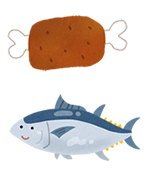
One of the symptoms after gastrectomy is a “feeling of food getting stuck.” The meal gets stuck in the stomach or throat and the person can no longer eat. It is one of the “small stomach symptoms.”
Vegetables can cause the feeling of food getting stuck. If you experience this, one of the solutions is to start eating from nutritious meat and fish. After gastrectomy, vegetables are not always good for your body.
Please consider them as “food that requires caution.” The “feeling of food getting stuck” from vegetables and white fish can be prevented by chewing them well.
Curry
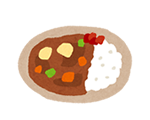
Among curries, “Bon Curry” is less oily and is OK to eat if you do not get diarrhea.
The volume of food to be eaten per day categorized by food and how to select food
Grains

You can have grains up to two light helpings in a normal-sized rice bowl. For the first one to two months after the surgery, start from rice porridge and soft cooked rice and gradually transition to regular cooked rice. It is important to have them as a staple food and slowly eat them by chewing them well.
Fish, meat and bean products

Good-quality protein from fish, meat and bean products is a nutrient essential for healing wounds from the surgery and recovering physical strength.
At this stage, it is recommended to steam or grill a slice of low-fat white fish with salt or butter. It is OK to eat sashimi (raw fish) if you select a fresh one.
Select parts of meat with low fat. Ground or slice lean meat and thigh meat of beef or pork and tenderloin of chicken. For a daily intake, start from the portion corresponding to a strip of chicken tenderloin.
In addition, livers are recommended as they are digestible and prevent anemia.
Refrain from eating fatty parts of meat such as ribs, bacon and sausages for a while.
Eggs

Eggs are a source of protein similarly to fish and meat. Take them proactively as they contain good-quality protein with essential amino acids in good balance and are digestible. You can eat one egg per day.
Select dishes cooked without oil or soft dishes such as soft-boiled eggs, poached eggs, steam egg custard and omelets.
Vegetables

As vegetables and potatoes contain a lot of fiber, they are hard to digest with digestive juice. However, as they contain vitamins and minerals, eat them by devising ways to cook them.
Boil spinach, carrots, daikon (white radish), pumpkins, potatoes and taros until they are soft. When you eat raw vegetables around one month after leaving the hospital, peel and deseed tomatoes and peel cucumbers.
Cooking methodIt is recommended to boil ingredients until they become soft or steam them in a pan to make them fluffy. Be careful not to burn them too much. Refrain from eating fatty food such as bacon, ribs and ham for a while. In terms of beans, tofu and yuba (tofu skin) are OK to eat. Natto (fermented soybeans) can be eaten if chewed well. Avoid deep fried food such as deep-fried tofu for a while. As Japanese cuisine involves various ingredients, nutrition can be taken in a well-balanced manner. It may be difficult to eat meals in the same way as before the surgery for a while. We hope that you will be able to eat them at least a little by devising ways. |
How to choose frozen food cleverly
After gastrectomy, the stomach becomes smaller and you will not be able to eat a large amount of food at a time. Making sure not to reduce the daily intake of food, try to reduce the portion per meal and increase the number of times to eat.
However, you may feel that it is a burden to think of balanced menus and cook them when you do not know what and how to eat. If you are not good at cooking, it may be even more concerning. In such cases, we hope that you can reduce your burden or concerns by taking advantage of frozen food.
Frozen processed food
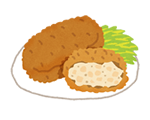
Frozen processed food such as croquettes, deep-fried food and karaage (fried chicken) is deep fried and seasoned heavily. It is best to avoid it for a while after the surgery.
Between immediately after leaving the hospital and three months thereafter, it is necessary to select digestive food, avoid oily food and heat the ingredients well until they become soft.
Frozen vegetables
Proactively use frozen materials (taros, pumpkins, broccoli, cauliflower, mixed vegetables, etc.) that are pretreated and ready to use. They will be very useful when you have to prepare your meals in a hurry as you can save time for shopping and heating.
Frozen vegetables are frozen rapidly and the fresh taste and nutrition are maintained. As they can be preserved for a long time, you can select ingredients freely irrespective of seasons.
As they are pretreated, it is easier to use them than cooking from scratch and the cooking time can be shortened.

We hope you can enjoy your meals easily by taking advantage of frozen food and selecting your food carefully. By using mixers, you can save cooking time because they break food into small pieces in a short amount of time. If you feel that food gets stuck, you can make a juice with a mixer.
Green vegetables rich in fiber (spinach, komatsuna [mustard spinach], etc.) can be turned into potage if you boil them until they are soft and mix them in a mixer by adding milk or soy milk. If you mix milk or soy milk with bananas in a mixer, you can make banana milk. It is also good for a snack.
When you cannot eat a regular meal, take advantage of food that supplements nutrition. As the portion of meals is unlikely to increase after gastrectomy, it is sometimes difficult to take enough nutrition. If you are concerned that your weight is not increasing as much as you wish, it is recommended to supplement nutrition that is lacking with nutritional supplementary food.
Convenient frozen vegetablesSpinachSpinach contains a large amount of carotene and iron. It is digestible and recommended for people with anemia. Other dishes include “clear soup with spinach and carrots” and “sautéed spinach” cooked with butter. TarosTaros contain a large amount of vitamin B1, potassium, galactan, mannan and mucin (mucus of taros) and are effective in recovering from fatigue. To make “stewed taros,” stew taros, carrots and turnips with stock and seasonings until they are soft. Please give it a try. |
How to select canned ingredients cleverly
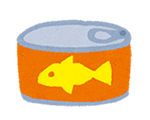
Beans, which are hard and take time to cook, can be cooked easily with the use of water-boiled ingredients in cans. Canned mackerel may contain a large amount of fat depending on the cooking procedure. Make sure to check the procedure before selecting. Stock up on canned soups and retort pouches.
While canned fruits contain less nutrition such as vitamins compared to fresh fruits, a small amount is recommended as they are digestible.
Seafood: canned abalones, squids, octopus, ham, bacon and salami are indigestible. Try to avoid them or devise ways to cook them.
Using convenience stores cleverly one month after returning to work

If it is difficult to prepare home-made bento boxes or snacks after returning to work, you can use bento boxes and snacks at your nearby convenient stores if you choose them carefully.
Convenience stores are accessible and convenient for shopping as they have a large number of stores. Most of them are open 24/7 and are very convenient.
They have a wide range of products such as bento boxes, precooked food, snacks, soups, drinks, bread and retort food that are separated into portions for one person, so take advantage of them. The important things are to select digestible food, chew well and to eat in moderation.
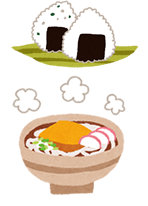
If you are choosing bento boxes, avoid choosing vegetables rich in fiber, deep-fried food that contains a large amount of fat (croquette, deep-fried chicken, pork cutlet, etc.), fatty meat (pork ribs, bacon, etc.), and indigestible seafood (squid, octopus, etc.).
Udon, somen, soba and soft onigiri (rice ball) are recommended as they are digestible.
Environmental hormone may be produced if you microwave the food in the container. Heat the food up after transferring it to a dish.
How to choose food
Bread

In terms of bread, egg salad sandwiches made with soft bread are recommended. While mayonnaise contains oil, it should not be a problem as long as you do not take a large amount as it is emulsified.
Croissant, Danish pastry, curry bread and deep-fried bread should be avoided as they are high in fat.
Side dishes
In terms of side dishes, tofu, soft-boiled egg, Japanese-style rolled omelet, and chawanmushi (savory steamed egg custard) are recommended as they are digestible.
Soups
When a bento box is not enough, we recommend a cup of miso soup, pork miso soup and corn cream potage.
However, avoid seaweed and burdocks as they are indigestible.
Dessert
For snacks, yoghurt, pudding, jelly, pancake, roll cake, nikuman (meant bun), anman (bun with a bean-jam filling), biscuit, banana and nutritional supplementary food are recommended.
As they are rich in variety, enjoy them daily as snacks and use them to recover your physical strength. If you have diarrhea, low-fat products such as dorayaki (bean-jam pancake) and yokan (sweet-bean jelly) are recommended.
Pacing your mealsIf you eat too much for breakfast, you may feel ill and your stomach may feel bloated for the whole day. Nourishment can be supplied sufficiently by taking snacks while keeping the portion of each meal moderate, taking nutrient, and dividing your meals into four or five times. |
Introduction of iEat, food for recovering eating function
What is food for recovering eating function?
A large number of patients face problems with their diet after gastrectomy. The family supporting such patients may also have trouble or worry about dietary support. Even if you try to make and have digestible and absorbent food, most of you may have a number of concerns such as what food is actually suitable, how soft the food needs to be for patients to eat, and forms of food.
We would like to introduce iEat, food for recovering eating function, to patients under such situations.
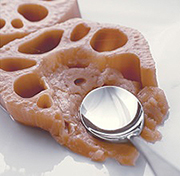
iEat is a meal that looks to be in a normal shape but is very soft. How soft is it? According to EN Otsuka Pharmaceutical Co., Ltd., which manufactures and sells this product, 1/1000 softness has been achieved. It is difficult to imagine. To put simply, it is soft enough to “be crushed with your tongue.” While making each ingredient to the maximum softness while keeping it in shape, using its unique technology, the unique texture of the ingredients has been maintained.
Here, we would like to report on iEat products that we have tried.
Carbohydrate
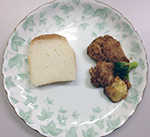
Bread and chicken cutlet
Bread loaf
Appearance: Looks completely like a bread loaf. When you touch it, it is soft and fluffy.
Aroma: Appetizing aroma like a freshly baked bread.
Opinion after eating: It felt a little watery, but it was sweet and tasty.
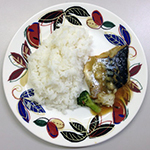
Rice and mackerel
simmered in miso
Rice
Appearance: It looks like watery rice. Grains of rice are not sticky and are crumbly.
Opinion after eating: It was sweet and tasty. Even though the grains were not sticky, it did not bother us much as it was soft as if to melt in our mouths.
Vegetables
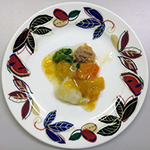
Assorted vegetables
Appearance: Looks exactly like stewed vegetables.
Aroma: Once you open the tray, an appetizing aroma of yuzu (citrus) spreads. It smells very good.
Opinion after eating: With the flavor of yuzu, it was tastier than we expected. Even those the main ingredients consist of root vegetables such as lotus roots, daikon and carrots, we were surprised to find all of them soft enough to be crushed with a tongue.
Fish
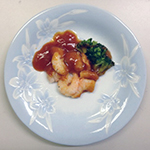
Ebi chili (shrimps in chili sauce)
Appearance: The shrimps are covered in chili sauce and the dish looks brilliant.
Aroma: A pleasant-smelling aroma of ebi chili spreads in the room.
Opinion after eating: While the texture is soft enough to melt in your mouth, you can enjoy the unique flavor of shrimps. As the sauce is seasoned relatively heavily, it increased our appetite. The broccoli on the side did not come apart in the mouth and it was moist and in shape.

Mackerel simmered
in miso and rice
Mackerel simmered in miso
Appearance: The glossy shine of the mackerel is appetizing.
Aroma: Stimulates your appetite with sweet aroma of miso.
Opinion after eating: Simply put, it was delicious. The unique flavor of mackerel remained, and it was far from dry.
Meat
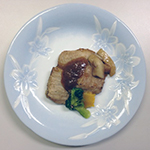
Ginger pork
Appearance: Looks more like meat than expected
Aroma: A well-balanced aroma of ginger and pork increases your appetite.
Opinion after eating: While the flavor was exactly like pork ginger, the texture was closer to that of white fish. It was similar to texture of fish stewed until soft that melts in the mouth.

Chicken cutlet
and bread loaf
Chicken cutlet
Appearance: At a glance, it can also look like chicken cutlet boiled in soy sauce with sugar
Opinion after eating: It was well-seasoned and very easy to eat. The texture was closer to that of white fish.
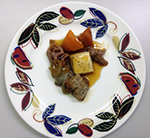
Sukiyaki-style assorted stew
Appearance: Vegetables, meat and tofu are all in shape.
Aroma: An aroma of sukiyaki spreads.
Opinion after eating: It was well-seasoned and was very delicious. The tofu was especially delicious—it was moist and soft. The beef was soft as if to melt in your mouth.
SummaryAll of the products had great aromas and the appearance as well as the smell increased our appetite. |
Frequently Asked Questions
-
Q.I was invited to dinners and drinks after returning to work. Could you tell me how to respond in a way that is considerate to the person who invited me while taking care of myself?
-
- When you have to avoid alcohol:
When you are offered to have alcohol, you could disturb the atmosphere if you turn it down resolutely. In such a case, you can maintain the good atmosphere by turning the conversation to the person by saying, “Thank you, but I have had enough. Would you like some?” - When you are offered something you do not like:
Try to answer by being considerate to the person who offered by saying “I am sorry, I do not really care for XX. I will have this instead.” - When you are invited to a banquet:
Start by providing a favorable response such as “A party? That sounds good, I would like to go.” And then turn down by saying “But I’m sorry, I have just had surgery on my stomach and I am supposed to give my stomach and liver a rest. I am grateful for your invitation, though. I will let you know once I can participate, so I would love to join next time.” In this way, the person who invited will not feel bad.
- When you have to avoid alcohol:
-
Q.It has been some time (1–3 months) since I returned to work and I have to attend a banquet for work. Can I have alcohol?
-
A.As your stomach has become smaller after your surgery, the content you put in your stomach such as alcohol and food can flow into your small intestine in a short time.
Compared to your stomach, your small intestine absorbs alcohol quicker and it is said that you feel drunk quicker after your stomach surgery compared to before the surgery. Enjoy your alcohol at a slow pace.The standard on a daily intake is around a glass (180 ml) of shochu (clear distilled liquor) or whiskey diluted with water, or a small glass (100 ml) of wine.
It is best to avoid carbonated beverages (such as beer and sour) as they make your stomach feel bloated.
Limit the intake of sake to around 100 ml as it is drunk undiluted and start drinking shochu and whiskey diluted with water rather than on the rocks.
-
Q.I don’t have physical strength and feel tired easily and I would like to keep my attendance to a banquet short. Could you please tell me how to inform that to the organizer?
-
A.If you are aware of the decline in your physical strength, it is a good idea to consider attending the party for a short time. How about considering going home early or arriving late? While it may depend on closeness between you and the organizer, etc., try to explain your illness and your current life briefly and ask the person to understand your short attendance.
For instance, how about telling the person “I have returned to work after the stomach surgery, but my condition is not back to normal yet and it is difficult for me to stay until the end of the party. I apologize for the inconvenience, but I would like to keep my attendance short. I would like to regain my strength and fully attend the next party.”
-
Q.I am worried that the pace of meals will be disrupted at banquets and dinner parties.
-
A.It is difficult to turn down invitations to banquets. It is acceptable to take it easy and make minimum effort at such events.
If you drink alcohol, how about having warm sake or shochu diluted with hot water instead of beer as it can quickly make your stomach feel bloated and cause diarrhea?
If you drink alcohol, you tend to become relaxed and eat too much.
Try to select food that you can eat slowly by chewing well and paying attention to the volume.
-
Q.Since some time (1–3 months) has passed since returning to work, I was invited to a dinner party by my colleagues. It is a hotel buffet dinner party and I would like to join. What do I need to keep in mind?
-
A.In the same way as your regular meals, select digestible food (Japanese-style food). If it is a buffet style meal, you can take suitable amount of what you can eat on plates. If you keep in mind to keep the volume relatively small and eat slowly, you will be able to enjoy your communication with your colleagues without reserve. Influenced by the surrounding atmosphere, you tend to eat more and quicker than usual. Enjoy your conversation with your colleagues while setting your goal to eat moderately.
-
Q.Since some time (1–3 months) has passed since returning to work, I was invited to go to my favorite Chinese restaurant by my colleagues on a weekend. It is my first time to eat Chinese food after the stomach surgery and I would like to go. What do I need to keep in mind?
-
A.If you are feeling well, there is nothing in particular that you cannot eat. In principle, it is best to enjoy delicious meals with a good nutritious balance. However, your digestive power has declined as a secretion of gastric juices and digestion enzyme has been reduced after the stomach surgery. Therefore, please be careful with dishes that use a lot of oil as it could cause a heavy feeling in your stomach. For ingredients and dishes that you have not eaten for a while since the surgery, take a portion onto your dish and start eating a small amount depending on your condition and appetite. We recommend Chinese congee, steamed flower rolls, soups, shaomais, steamed dumplings and stir fry eggs with crab meat. Ramen noodles contain a thickener called lye water (aqueous solution containing alkali salt) and are indigestible, so please be careful.
-
Q.I have had stomach surgery. Since some time (1–3 months) has passed since returning to work, I would like to go to an izakaya (bar) with my colleagues. What can I eat there?
-
A.Izakayas have a wide variety of dishes. Enjoy your time with your colleagues by paying attention to the volume and how to choose your food.
For the first 1–3 months after returning to work, sashimi tends to be avoided. However, it is OK to eat if it is fresh. In particular, we recommend low-fat white fish sashimi. Avoid shellfish except for oysters as they are indigestible. However, it is best to avoid raw oysters to prevent food poisoning.Intense sweetness and saltiness irritate the stomach walls and intestinal wall. Select dishes so you can avoid intense sweetness or saltiness as much as possible. Avoid overly cold or hot drinks as they also irritate them.
There are a number of oily dishes on izakaya menus. If you take a large amount of oil at a time, it may cause diarrhea as it is hard to digest and absorb. Be careful with deep-fried food as well as vegetables rich in fiber such as burdocks and seaweed salad as they are indigestible.
Grilled-liver on skewers tends to be avoided but it is rich in minerals such as iron and in vitamins. Depending on the atmosphere of the izakaya, you might be able to eat dishes like this.
As you tend to eat main dishes at the end, please pay attention to the volume.
-
Q.I am invited to a French dinner party. Can I attend it?
-
A.You may feel that the French cuisine should be avoided as there is an impression that the French course menus contain a lot of oil and have a large volume. However, it is an excellent dietary style in a way that you take time to eat your meal. It should not be a problem if you pay attention to the below points.
- Pay attention to the ingredients and avoid dishes that contain ingredients rich in fiber and that are not digestible. It is OK to eat white fish and low-fat meat. Avoid indigestible ingredients such as squids, octopus, seaweed, celery and nuts.
- Pay attention to the cooking method and select dishes that use little oil, butter, or spices. We recommend heated vegetables, steamed white fish mousse, fish piccata and stew cooked until soft. While soups are digestible, it is best to have only a small amount as they are filling.
- For dessert, avoid menus that contain ingredients rich in fiber. We recommend cooked fruit compotes, Bavarian cream, pudding, bananas and peaches. Avoid fruits with seeds such as strawberries and kiwi fruit and fruits rich in fiber such as pineapples.
- The whole volume from the appetizer to the dessert might be too much. We recommend asking to reduce the whole volume to one third or ordering an à la carte meal. It is also a good idea to share with a child or an elderly person with a small appetite or start with lunch in a small volume.
- In most cases, French cuisine restaurants require reservations. How about explaining your illness at the time of the reservation and ask to change the menu or volume to a degree that will not be inconvenient to the restaurant? If the change is not possible, you could tell them in advance “I’m sorry that I cannot finish the food because I have just had surgery.”
-
Q.I am invited to an Italian dinner party. Can I attend it?
-
A.Famous Italian dishes include spaghetti Bolognese, pizza and lasagna. Dishes are mainly seasoned with tomatoes, butter and fresh cream. Main ingredients used include garlic, olives, olive oil, seafood (mainly octopus and squids), processed meat such as salami and bacon, and cheese.
Seafood (mainly octopus and squids) and processed meat such as salami and bacon are indigestible. Select digestible dishes.
Example:
Select slowly stewed soup-style spaghetti.
Risotto is also digestible as it has been boiled well.
In terms of meat, low-fat meat and chicken are suitable.
-
Q.I have had stomach surgery. Since some time (1–3 months) has passed since leaving the hospital, is it OK to go eat yakiniku (barbeque) with my work colleagues?
-
A.We hope you will have a great time eating yakiniku with your close colleagues. Good-quality protein is an essential nutrient for healing wounds from the surgery and recovering your physical strength. It will be good to efficiently take in such protein in your diet.
For the first 1–3 months after leaving the hospital, the volume corresponding to one strip of tenderloin is suitable. While you will not be able to eat as much as you did before the surgery, it is OK to eat parts with less fat and skin such as parts with lean meat of beef and pork and chicken tenderloin. We also recommend liver as it prevents anemia and is digestible. Fat may cause diarrhea as it is hard to digest and absorb. Avoid fatty meat such as ribs and bacon for a while.
Moreover, as some yakiniku sauces are heavily seasoned and spicy, they may irritate the gastrointestinal tract. Instead of a sauce, you could put lemon juice on the meat. Acid encourages a secretion of digestive juice. Make sure to remove the inner skin and seeds if you are having citrus fruit.
A person whose stomach was completely removed in the surgery often suffers from anemic conditions. To supplement the lack of iron, it is best to proactively select parts rich in iron such as beef, pork and chicken liver. Meat contains a lot of good-quality animal protein that improves the efficiency of iron.
Various parts of your body including the gastrointestinal tract are strained after surgery. We hope you will feel relaxed by having a friendly meal with your colleagues.
-
Q.I have had stomach surgery and it has been one month since I left the hospital. Before the surgery I mainly used to eat Japanese food. What are the things I need to keep in mind in terms of diet from now on?
-
A.Given that the amount you can eat at a time is small at this stage, it is important to devise ways to take necessary nutrition sufficiently. While the function of the gastrointestinal tract has recovered gradually, there are food and dishes that you need to be careful with after the surgery. Those include brown rice, mochi (rice cake), ramen, shellfish, fish paste (excluding hanpen), fatty meat, deep-fried tofu and bean curd, garlic chives, royal ferns, bamboo shoots, burdocks, lotus roots, and seaweed (laver boiled down in soy is acceptable).
Above all, you need to be careful with sushi, steamed rice with red beans, squids, octopus and shirataki (noodles made from konnyaku [devil's tongue starch]). However, it does not mean that you cannot eat them at all.
Be careful right after the surgery or when you are unwell. Be careful with food that makes you ill after eating. Instead of starting with the entire portion for one person, try to increase the volume gradually depending on your condition.
-
Q.Is it OK to eat to buy precooked food at supermarkets and department stores?
-
A.It is hard to cook every day while taking care of your health. We believe it is OK to have some days on which you use precooked food at supermarkets and department stores. While there are impressions that a lot of oil and salt are used in precooked food, you can take advantage of them effectively by being mindful of below:
- Pay attention to the ingredients and avoid dishes in which ingredients rich in fiber and are indigestible are used.
- Pay attention to the cooking method and select dishes with less oil, salt and spices. For instance, we recommend heated vegetable salad, assortment of separately cooked vegetables, stewed fish and steamed fish.
- If the dish is seasoned heavily, you could boil it with other ingredients or eat it with other ingredients on the side.
- Dishes to avoid include deep-fried dishes and tempura, in which a lot of oil is used, and raw vegetable salad, sautéed burdock root, stewed hijiki (edible brown algae) and stewed dried strips of daikon, which are indigestible. Try starting with a small amount of deep-fried and tempura white fish, pumpkins and potatoes, which are digestible, after approximately six months after the surgery.
If you are purchasing precooked food to shorten the cooking time and labor, how about considering using cut vegetables and seasoning mix and cooking using a microwave?
-
Q.Could you tell me the calories of alcohol?
-
A.100 ml or a glass of wine is 80kcal.
30 ml of undiluted brandy is 80kcal. After gastrectomy, alcohol is absorbed more quickly and makes you feel drunk easily. Reduce the amount of undiluted liquor and choose to dilute it with water rather than on the rocks to drink slowly.
A cup (180 ml) of sake is 200kcal.
50 ml of undiluted shochu (clear distilled liquor) is 80kcal. As carbonated beverages make your stomach feel bloated, it is best to dilute it with hot water.
-
Q.Is chocolate OK to eat?
-
A.Three pieces of chocolate are 80kcal. As it contains a lot of fat, it may cause diarrhea.
-
Q.Is yuzu (citrus) OK to have?
-
A.Be careful with acidic food for the first three to six months after the surgery. It is OK to have it if you mix it with other ingredients such as honey.
-
Q.Is umeshu (plum wine) OK to drink?
-
A.It is OK if you dilute it. It is best to cool it down if it’s hot and avoid having it cold.
-
Q.My father sometimes drinks alcohol without listening to the family. There have not been any symptoms so far. Is it OK?
-
A.It is OK if there are no symptoms.
-
Q.I have lost weight and cannot regain weight. What should I do when I want to gain weight?
-
A.Please come in for a consultation as we would like to confirm whether you are eating food that will put on weight or not. Please consult with a certified nutritionist regarding your concerns even if they seem little.
-
Q.Could you tell me how to judge whether I can go to the gym regularly?
-
A.It is not good to put pressure on your body when you are not taking in energy. Please check your pulse during the exercise for reference. It should be around 120 beats per minute. Muscles have a nature to get stronger as defense. Excessive loads require proteins. If you are lacking energy and put pressure on your body, it could take energy away from the muscles. You must make sure to exercise with low loads.






